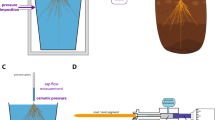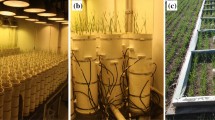Abstract
The issue of water flow through the root zone of field crops represents a complex problem requiring knowledge of a large spectrum of phenomena from various disciplines. Although many investigations have been devoted to gain better understanding of water dynamics in the root zone, the problem is still insufficiently understood. The main objective of the presented work was to analyze the importance of root water resistivity in the plant water extraction process. The problem was solved numerically for a wide range of the soil–root conductivity ratio (SRCR). Two different types of root water uptake (RWU) mechanisms were obtained. The first one is related to low root resistivity or low SRCR, and, thus, exhibits a so-called “moving uptake front” (MUF) effect observed previously in several experimental studies. The second one is inherent in large values of root resistivity or high values of SRCR (larger than 104), and is strongly dependent on the root density distribution.
Similar content being viewed by others
References
Allen, R.G., Pereira, L.S., Raes, D., Smith, M.: FAO – Food and Agricultural Organization of the United Nations, M-56, USBN 92-5-104219-5, Rome (1998)
Bresler E., McNeal B.L. and Carter D.L. (1982). Saline and sodic soils. Principles-Dynamics-Modeling. Springer – Verlag, Berlin Heidelberg New York
Cardon G.E. and Letey J. (1992a). Plant water uptake terms evaluated for soil water and solute movement models. Soil Sci. Soc. Am. J. 32: 1876–1880
Cardon G.E. and Letey J. (1992b). Soil-based irrigation and salinity management model: I. Plant water uptake calculations. Soil Sci. Soc. Am. J. 56: 1881–1887
Cardon G.E. and Letey J. (1992c). Soil-based irrigation and salinity management model: II. Water and solute movement calculations. Soil Sci. Soc. Am. J. 56: 1887–1892
Feddes R.A., Bresler E. and Neuman S.P. (1974). Field test of a modified numerical model for water uptake by root systems. Water Resour. Res. 10: 1199–1206
Feddes R.A., Kowalik P.J., Malinka K.K. and Zaradny H. (1976). Simulation of field water uptake by plants using a soil water dependent root extraction function. J. Hydrol. 31: 13–26
Gärdenäs A.I., Hopmans J.W., Hanson B.R. and Šimùnek J. (2005). Two-dimensional modeling of nitrate leaching for various fertigation scenarios under micro-irrigation. Agric. Water Manage. 74: 219–242
Gardner W.R. and Ehlig C.F. (1962). Some observations on the movement of water to plant roots. Agron. J. 54: 453–456
Gardner W.R. (1960). Dynamic aspects of water and availability to plans. Soil Sci. Soc. Am. Proc. 89: 63–73
Gardner W.R. (1964). Relation of root distribution to water uptake and availability. Agron. J. 56: 41–45
Gardner W.R. (1991). Modeling water uptake by roots. Irrigation Sci. 12: 109–114
Gradmann H. (1928). Untersuchunger Über die Wasserverhältnisse des Bodens als Grundlage des Pflanzenwachstums. Jahrb. Wiss Bot. 69(1): 1–100
Herkelrath W.N., Miller E.E. and Gardner W.R. (1977). Water uptake by plants. 2. The root contact model. Soil Sci. Soc. Am. J. 41: 1039–1043
Hillel D. (1975). Evaporation from bare soil under steady and diurnally fluctuating evaporativity. Soil Sci. 120: 230–237
Hillel D. (1980). Application of Soil Physics. Academic Press, New York
Hoffman, G.J., Howell, T.A., Solomon, K.H.: Management of Farm Irrigation Systems, ASAE Monograph, The American Society of Agricultural Engineers (1990)
Huber B. (1924). Die Beurteilung des Wasserhaushaltes der Pflanze, Ein Beitrag zur Vergleichenden Physiologie. Jahrb. Wiss. Bot. 64: 1–120
Humphries S.W. and Long S.P. (1995). WIMOVAC: a software package for modeling the dynamics of plant leaf and canopy photosynthesis. CABIOS 11: 361–371
Hupet F., Lambot S., Feddes R.A., van Dam J.C. and Vanclooster M. (2003). Estimation of root water uptake parameters by inverse modeling with soil water content data. Water Resour. Res. 39(11): 1312–1339
Jones J.W., Zur B., Boote K.J. and Hammond L.C. (1982). Plant resistance to water flow in field soybeans: I. Non-Limiting soil moisture. Agron. J. 74: 92–98
Kramer, P.J., Boyer, J.S.: Water relations of plants and soils. Academic Press (1995)
Li Y., Fuchs M., Cohen Y. and Wallach R. (2002a). Water uptake profile response of corn to soil moisture depletion. Plant, Cell Environ. 25: 491–500
Li Y., Wallach R. and Cohen Y. (2002b). The role of soil hydraulic conductivity on the spatial and temporal variation of root water uptake in drip-irrigated corn. Plant Soil 243: 131–142
Lynn B.H. and Carlson T.N. (1990). A stomatal resistance model illustrating plant vs external control of transpiration. Agric Forest Meteorol 52: 5–43
Miyamoto N., Steudle E., Hirasawa T. and Lafitte R. (2001). Hydraulic conductivity of rice roots. J. Exp. Bot. 52(362): 1835–1846
Molz F.J. and Remson I. (1970). Extraction of soil moisture use by transpiring plants. Water Resour. Res. 6(5): 1346–1356
Mualem Y. (1976). A new model for predicting the hydraulic conductivity of unsaturated porous media. Water Resour. Res. 12: 513–552
Neuman, Sh. P., Feddes, R.A., Bresler, E.: Finite Element Simulation of Flow in Saturated – Unsaturated Soils Considering Water Uptake by Plants, Project No. ALO-SWC-77, Technion, Haifa, Israel (1974)
Newman E.I. (1969a). Resistance to water flow in soil and plant: I. Soil resistance in relation to amount of root: theoretical estimates. J. Appl. Ecol. 6: 1–2
Newman E.I. (1969b). Resistance to water flow in soil and plant: II. A review of experimental evidence on the rhizosphere resistance. J. Appl. Ecol. 6: 261–272
Nimah M.N. and Hanks R.J. (1973a). Model for estimating soil water, plant and atmospheric interrelations, 1. Description and sensitivity. Soil Sci. Soc. Am. Proc. 37: 522–527
Nimah M.N. and Hanks R.J. (1973b). Model for estimating soil water, plant and atmospheric interrelations, 2. Field test for model. Soil Sci. Soc. Am. Proc. 37: 528–531
Nobel P.S. and Cui M. (1992). Hydraulic conductances of the soil, the root-soil area gap and the root: changes for desert succulents in drying soil. J Exp. Bot. 43: 319–326
Nobel, P.S.: Physiochemical and environmental plant physiology, Academic Press (1999)
Ogata G., Richards L.A., Fungardi A.A. and Drake R.L. (1960). Soil moisture availability for transpiration. Resour. Res. 4(6): 1161–1169
Philip J.R. (1957). The physical principles of soil water movement during the irrigation cycle. Irrig. Drain. Quest. 8: 125–154
Polak A. and Wallach R. (2001). Analysis of soil moisture variations in an irrigated orchard root zone. Plant Soil 233: 145–159
Reid J.B. and Huck M.G. (1990). Diurnal variation of crop hydraulic resistance: a new analysis”. Agron. J. 82: 827–834
Rose C.W. and Stern W.R. (1967). Determination of withdrawal of water from soil by crop roots as a function of depth and time. Aust. J. Res. 5: 11–19
Rowse H.R., Stone D.A. and Gerwitz A. (1978). Simulation of the water distribution in soil. 2. The model for cropped soil and its comparison with experiment. Plant Soil 49: 534–550
Saxton, K.E.: Mathematical modeling of evapotranspiration on agricultural watersheds, In: Singh, H. (ed.) Modeling Components of the Hydrologic Cycle, 183–203 (1982)
Šimùnek, J., Šejna, M., and van Genuchten, M. Th.: The HYDRUS Software Package for Simulating the Two- and Three-Dimensional Movement of Water, Heat, and Multiple Solutes in Variably-Saturated Media, User Manual, Version 1.0, PC-Progress, Prague, Czech Republic (2006)
Steudle E. and Peterson C.A. (1998). How does water get through roots?. J. Exp. Bot. 49(322): 775–788
Steudle E. (2000). Water uptake by plant roots: an integration view. Plant Soil 226: 45–56
Taylor H.M. and Klepper B. (1975). Water uptake by cotton root systems: an examination of assumptions in the single root model. Soil Sci. 120: 57–67
Taylor H.M., Upchurch D.R. and McMichael B.L. (1992). Root hydraulic resistance: implication in modeling nutrient and water uptake. J. Plant Nutr. 15: 727–736
Tratch, D.: Moisture uptake within the root zone, M.Sc. Thesis, Department of Civil Engineering, University of Saskatchewan, Saskatoon, Saskatchewan, Canada (1996)
van Bavel C.H.M., Stirk G.B. and Brust K.J. (1968). Hydraulic properties of a clay loam soil and the field measurements of water uptake by roots, 1. Interpretation of water content and pressure profiles. Soil Sci. Soc. Am. Proc. 32: 310–317
van den Honert T.H. (1948). Water transport as a catenary process. Faraday Soc. Discuss. 3: 146–153
van Genuchten M.Th. (1980). A closed-form equation for predicting the hydraulic conductivity of unsaturated soils. Soil Sci. Soc. Am. J. 44: 892–898
van Genuchten, M. Th.: A Numerical Model for Water and Solute Movement in and Below the Root Zone, U.S. Salinity Laboratory, USDA-ARS, Riverside, CA (1987)
Whisler F.D., Klute A. and Millington R.J. (1968). Analysis of steady-state evapotranspiration from a soil column. Soil Sci. Soc. Am. Proc. 32: 167–174
Zuo Q. and Zhang R. (2002). Estimating root-water-uptake using an inverse method. Soil Sci. 169(9): 561–571
Zur B., Jones J.W., Boote K.J. and Hammond L.C. (1982). Total resistance to water flow in field soybeans: II. Limiting soil moisture. Agron. J. 74: 99–105
Author information
Authors and Affiliations
Corresponding author
Additional information
Deceased.
Rights and permissions
About this article
Cite this article
Levin, A., Shaviv, A. & Indelman, P. Influence of root resistivity on plant water uptake mechanism, part I: numerical solution. Transp Porous Med 70, 63–79 (2007). https://doi.org/10.1007/s11242-006-9084-1
Received:
Accepted:
Published:
Issue Date:
DOI: https://doi.org/10.1007/s11242-006-9084-1




